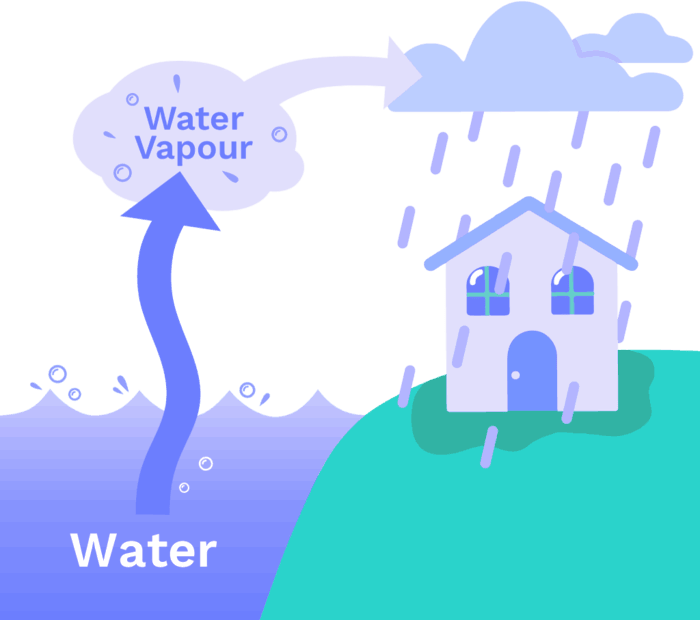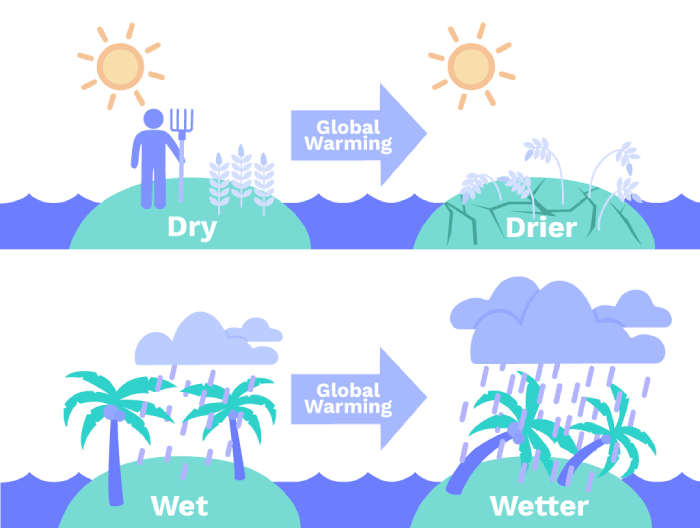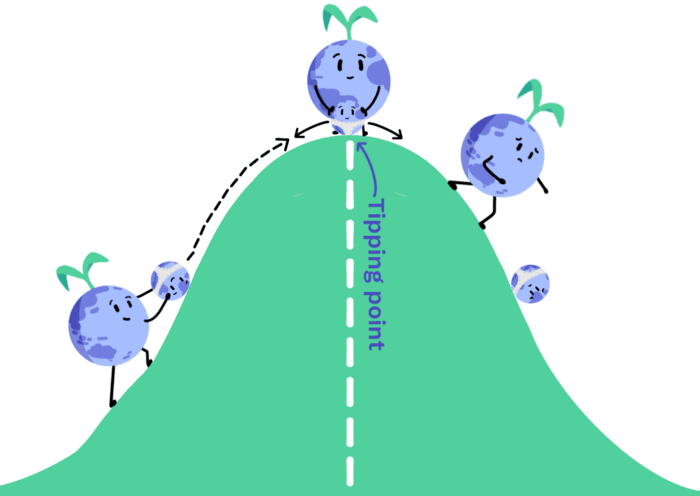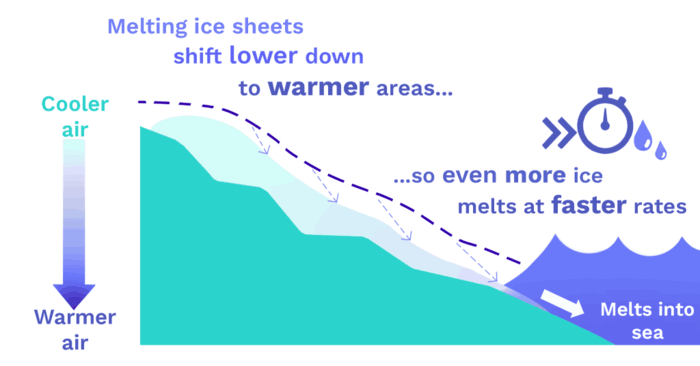Future Climate: How exactly will the climate change?
9 minute read
Updated on: 03 Mar 2021
All of these things will happen on a hotter planet and there is also the risk of crossing climate tipping points
.
Lots to cover! Let’s take a look at changes in rainfall first.
How will rainfall change in the future?

Increasing rain with global warming
‘Rainfall intensity’ - the amount of rain falling at a given time in a local region - will increase. In fact evidence suggests that for every 1°C of global warming, heavy rainfall events (rather than drizzle) could occur 5-10% more often
. Therefore, more of the land on Earth will be at risk of flooding
.
But won’t some places get drier? Yes indeed! The changes in rainfall are predicted to be uneven
so some regions will become wetter, others will become drier, and some will hardly change
.
In part, this is because some parts of the atmosphere will warm more than others, so they will be able to hold more water.
There will also be changes in the flow of air in the atmosphere which will change the ways in which water is distributed across the globe.
Overall, land regions far away from the equator will become wetter, whilst land regions closer to the equator will become drier if they are already dry, and wetter if they are already wet!

Drier and Wetter
This means in some regions there will be less rainfall making droughts more likely to happen. Furthermore, in a hotter world, the severity of droughts is likely to increase
.
If global warming goes beyond 2°C, more droughts are predicted to occur in the Mediterranean, southwestern USA and southern African regions.
This could seriously affect the ability for all people to be able to access enough safe and nutritious food. This is because if the soil dries up, it is harder to grow crops
.
How does global warming cause Sea Level Rise?
For the past few thousand years, sea levels have been stable, but since 1901 the average global sea level has risen by 19 centimetres
.

Causes of Sea Level Rise
These huge areas of ice, which rest on land, are called ice sheets. There are two ice sheets in the world, one in Greenland, and one in Antarctica
.
In the past few decades, global warming has caused parts of ice sheets to melt and shrink. Therefore, water once stored on land now spreads out into the ocean
.
On the other hand, melting icebergs don’t contribute much at all to sea level rise because the extra water simply replaces the ice in the space it filled before.
Since 2006, melting ice sheets have caused sea levels to rise 1.8 millimetres a year. This is an even bigger contribution than expansion, which caused an increase of 1.4 millimetres per year in the same time period
.
How will sea level change in the future?
You can see a range of possible forecasts for sea level rise in the graph below.
By 2100, if there is no change in climate policy, sea levels are expected to rise by 15 millimetres per year, and several centimetres a year by 2200!
To make matters worse if the Greenland and Antarctic ice sheets lose too much ice they will pass a tipping point which could eventually lead to over 7 metres of sea level rise
!
But wait let’s take a step back.
What is a Tipping Point and why are they so important?
Imagine rolling a ball up a hill. As you walk up the hill, if you push the ball up a bit it will simply roll back into your hands.
However, once you roll the ball over the top of the hill it will keep on rolling away and you’ll lose it. Here, the top of the hill is the ‘tipping point’; at that point if you give the ball the tiniest extra push it will roll away from you and won’t stop!

Ball on hill Tipping Point
Normally, our Earth’s systems behave in a similar way to the ball at the bottom of the hill - if we give them a little push by changing them slightly, they will eventually return to their natural state. However, if we cause our Earth system to change a lot (like by hugely increasing the temperature
), the ball moves to the top of the hill, so any little extra push will cause a huge and irreversible change
. This is called a ‘tipping point’
.
Crossing a tipping point is irreversible because you can’t go back by undoing the small change. The small extra change has triggered a system shift, which can be immediate
, or delayed years into the future
.
What would cause the Greenland and Antarctic Ice Sheets to pass a tipping point?
The Greenland and Antarctic ice sheets will pass a tipping point when the area of ice lost becomes so large that it is impossible to stop the rest of the ice sheet from melting too.
The Greenland ice sheet is heading towards this point because as it melts, it moves to lower areas of land. Because air is warmer on lower land the rate of melting increases.

Ice Sheet melting Feedback
If the Greenland and western Antarctic ice sheets cross their tipping points, we have to expect several metres of sea level rise in the next few hundred years.
When will Greenland and Antarctica cross this tipping point?
Generally, there is little agreement about whether any tipping points will be crossed before 2100 due to lack of data and the difficulty climate models face in representing these processes
.
Although the best climate models nowadays can consider many abrupt changes in climate, some processes are still unexplained
.
Therefore, while some scientists argue that global mean surface temperatures would have to increase by at least 2°C, others say that 1.5°C warming is enough to push ice sheets past a tipping point - this is likely to happen as early as 2030
! In fact, some believe we have already crossed ice sheet tipping points
, and if not we are ’dangerously close’
.
Will everything be fine if we don’t cross this tipping point?
Even if global warming is limited to 1.5°C and no tipping points are crossed, sea level rise will continue. In fact, even if the amount of greenhouse gas in our atmosphere stayed constant from now on, sea levels would continue to rise for hundreds, even thousands, of years
.
This is due to delayed warming - sea water needs much more energy and time to warm up than land or the atmosphere.

Delayed Ocean Warming
Conclusion
Rising sea levels, flooding and droughts will pose a huge risk to human health, food supply, buildings, transport and wildlife.
Moreover, leading scientists in the field of tipping points have said we should aim to keep well below 2°C global warming to avoid crossing any tipping points
. (Remember, we have already warmed our planet by 1.1°C
!).
Therefore, it is vital that we slow global warming as much as possible.
Go to quiz!

